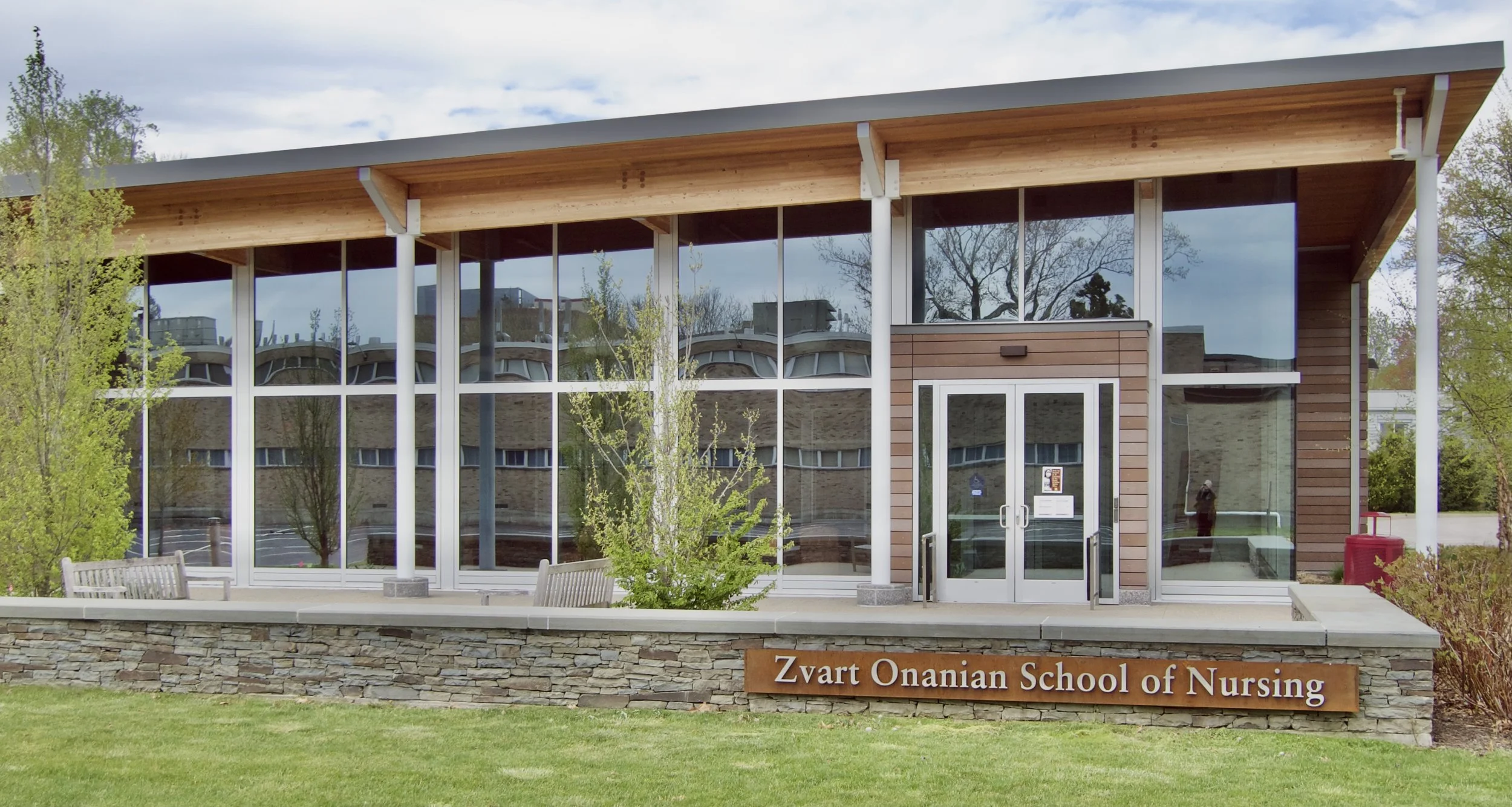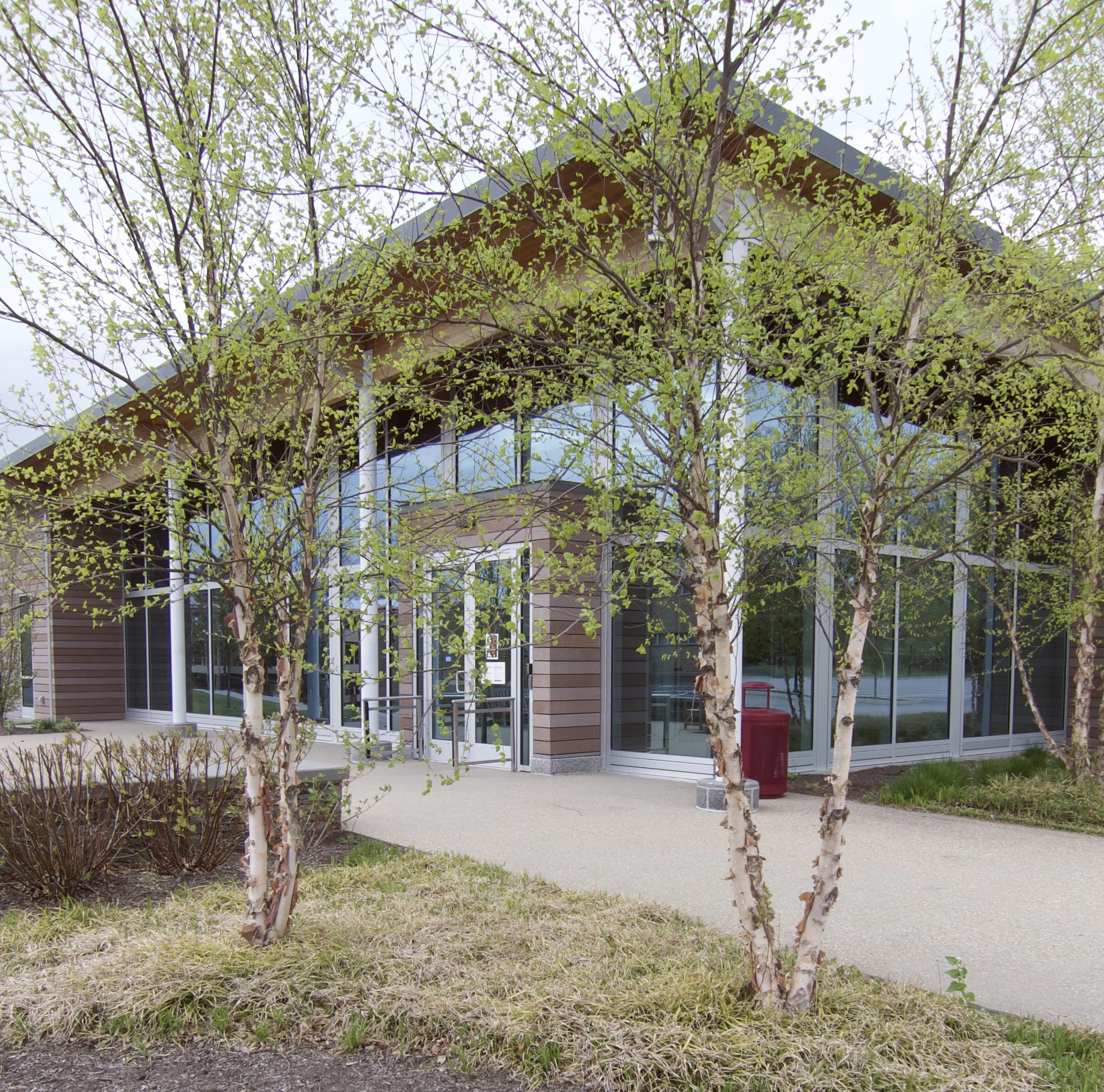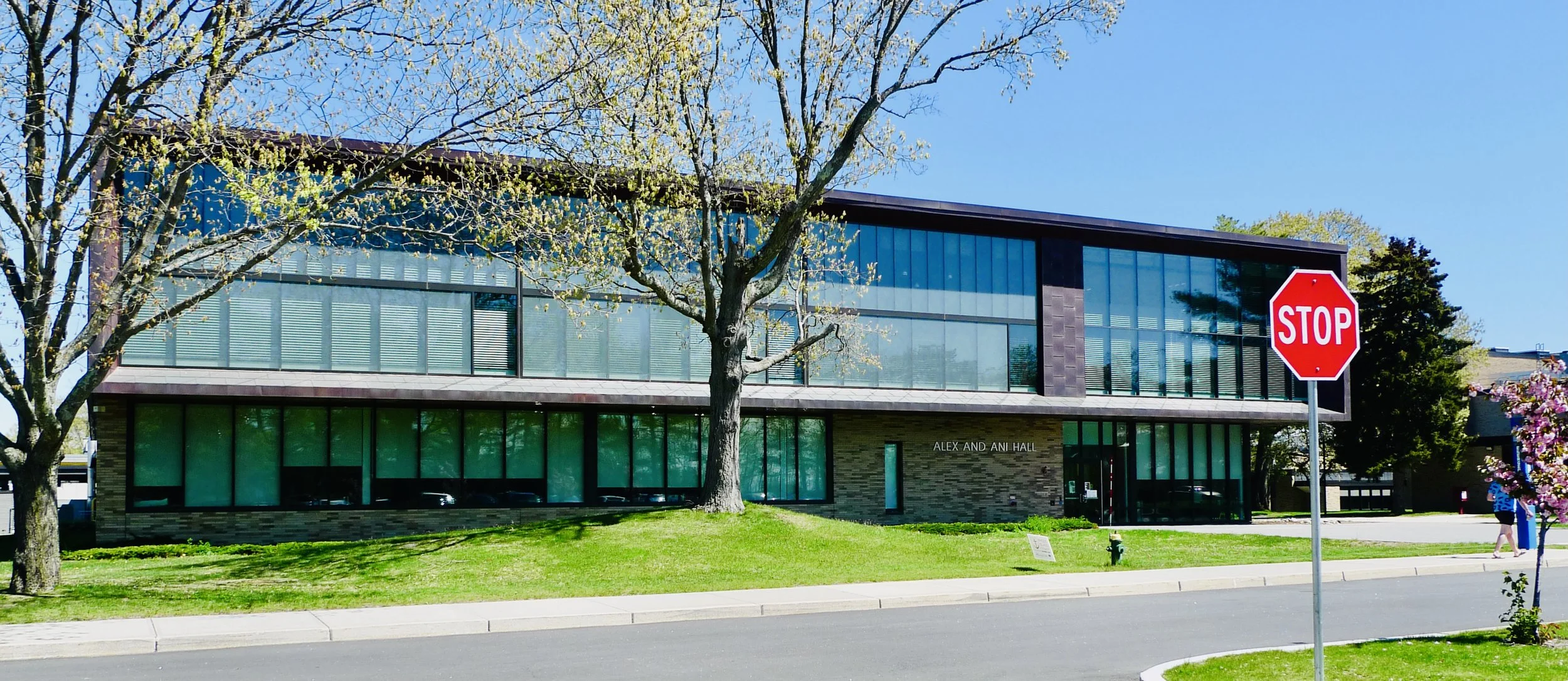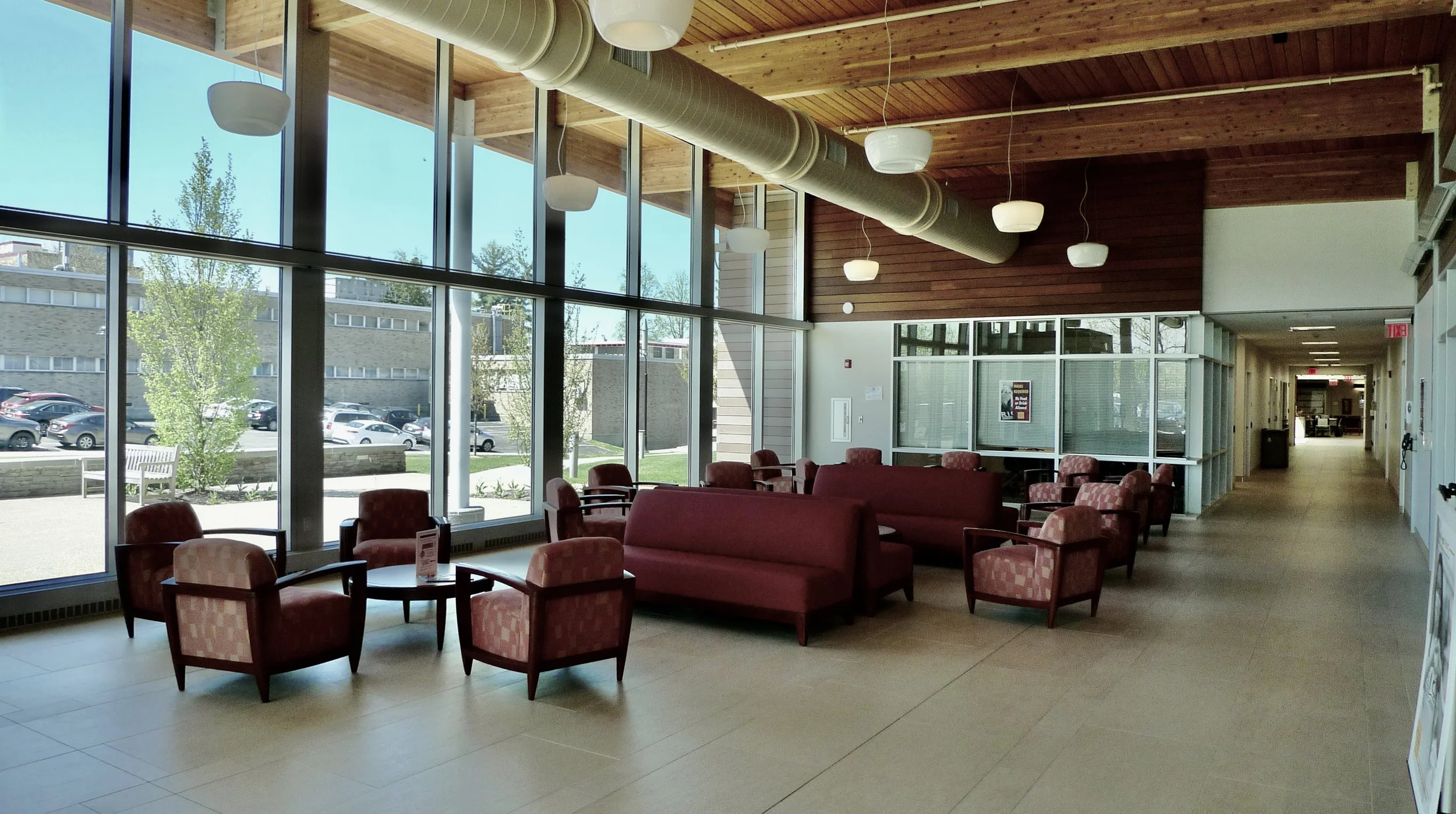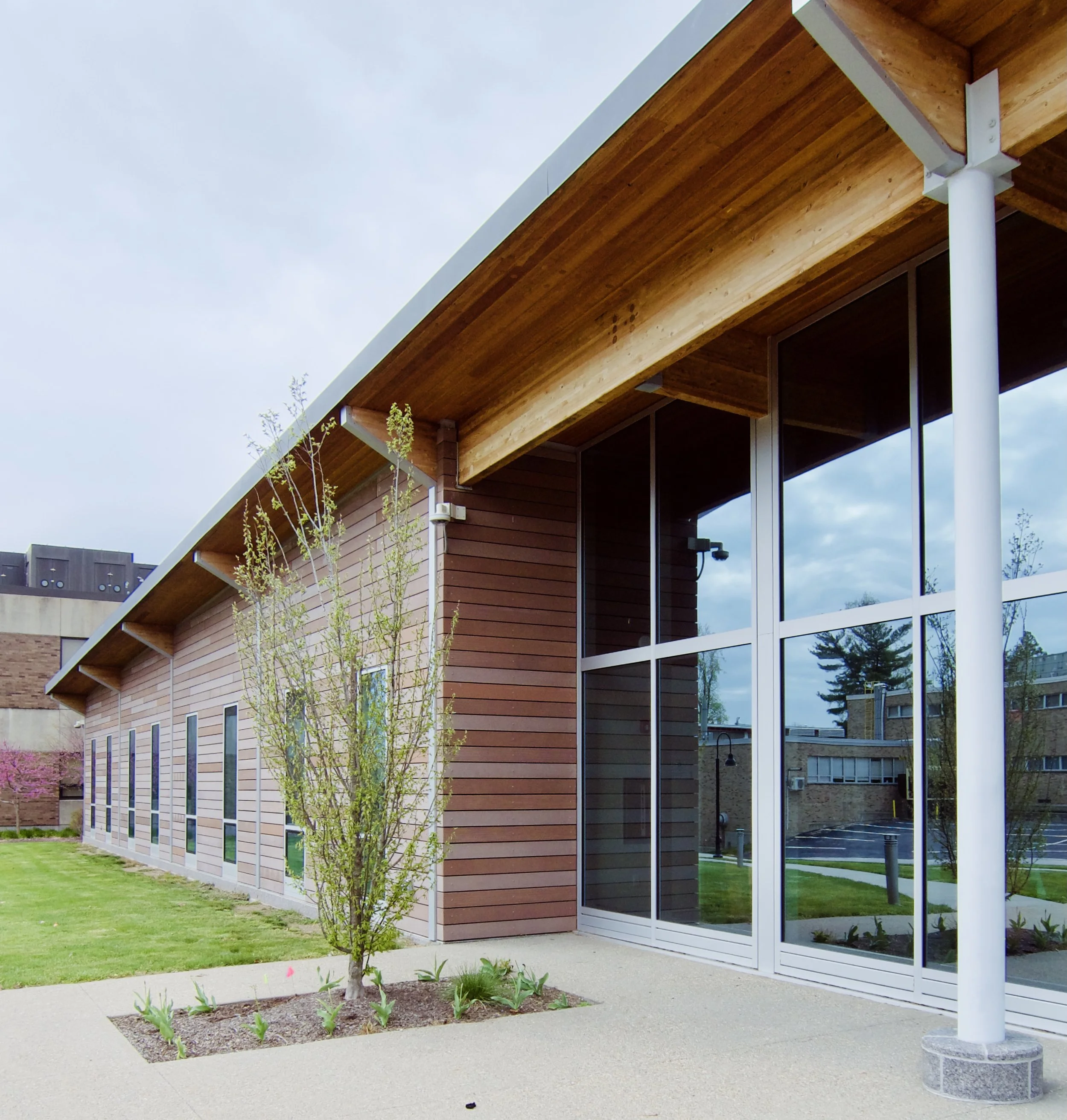
William Morgan: Less is more at RIC nursing-school building
At Rhode Island College, in the Mount Pleasant section of Providence.
— Photos by William Morgan
The home of the recently named Zvart Ononian School of Nursing at Rhode Island College is a handsome and noteworthy addition to the architectural scene in Providence. Not unlike the public-education sector that built it, and the nursing profession itself, the 12,000-square-foot facility is modest, accomplished and without pretense.
Since its beginning, in 1970, RIC’s nursing program has been in the Fogarty Life Sciences Building. In recent years it has been desperately in need of additional space. And an important need has been to establish a visual identity for the School of Nursing. Fogarty, to which the Ononian is attached, is typical of so many of the buildings at RIC: buff brick functionalism that proclaims its post-World War II public university aura.
The School of Nursing’s building went up six years ago, but received little notice until the school received $3 million this year in honor of licensed practical nurse Zvart Ononian
Rhode Island College moved out from downtown Providence to 180 acres of rolling Mount Pleasant landscape in 1958, but the countryside remained about the only thing that distinguished the campus. Its scattering of two-story, flat-roofed classroom buildings appeared like a combination of parochial high school and Midwestern agricultural college. (The style, no doubt, reflected economic reality as much as any philosophy of architects Howe, Prout & Ekman.) RIC’s architectural image started to look up with the construction of the John Nazarian Center for the Performing Arts, in 2000. The theater, designed by William Warner, a prime mover in the Providence Renaissance, has been joined by the sleek, copper-sheathed Alex + Ani Hall, by the respected Boston architects Schwartz/Silver
The Art classroom building at RIC, Alex + Ani Hall.
Unlike the art building’s stylistic variation on the theme of the earlier campus structures, the School of Nursing’s single-pitched, sloping roof creates a subtler, less institutional approach. And, instead of two stories squished together, the new building offers a high and welcoming gathering space, bathed in light from full-height windows. Gathered around this spacious hall are administrative offices, meeting rooms and simulation laboratories for hands-on training.
Inside the nursing school.
JMT Architecture, designers of the nursing school addition, have 1,600 employees, with offices in Baltimore, Philadelphia and Cleveland. While no one would confuse JMT with famous starchitects, or a small studio firm, they run a highly successful commercial enterprise that delivers dependable workmanlike buildings to satisfied clients. The RIC Nursing School doesn’t knock one’s socks off with architectural pyrotechnics, but it does not look money-starved, as publicly funded school design often does.
Entrance to Ononian School of Nursing. Thoughtful use of inexpensive materials.
The curtain wall mullions could be a little more sophisticatedly detailed, and the boxy entry vestibule is a little awkward. But the laminated timber implies strength; the entire materials palette, especially the concrete plank covering, complements the wood framing. This is a gentle, sensibly proportioned building that does not try too hard. The most appealing aspect of the school of nursing is perhaps the landscaping, where river birches set amidst natural grasses contribute a pastoral Scandinavian ambience.
Entrance to Ononian School of Nursing. Thoughtful use of inexpensive materials.
Administrators and the simulation-lab coordinator who spoke with GoLocal had only positive things to say about the nursing school building. The idea that appealing architectural design would attract students did not seem to be a consideration. Rather, it is the desire to offer an affordable nursing degree that matters. Even if the relationship of good design to academic success is unarticulated, the nursing facility is a happy place to teach and learn, as well as the attractive face of the school.
And compared to the silliness of expensive and inappropriate architectural statements, such as the fatuous RISD student center or Brown’s Performing Arts fiasco, the Zvart Ononian School of Nursing at Rhode Island is a welcome grace note.
Architecture writer and historian William Morgan is the author of a number of books about campus architecture, including Collegiate Gothic (Universty 0f Missouri Press) and The Almighty Wall (MIT Press).
John O. Harney: An early look at 2022’s college-commencement season in New England
BOSTON
From The New England Journal of Higher Education (NEJHE), a service of The New England Board of Higher Education (NEBHE.org)
Long before COVID changed everything, NEJHE and NEBHE’s Twitter channel kept a close eye on New England college commencements. “The annual spring descent on New England campuses of distinguished speakers, ranging from Nobel laureates to Pulitzer Prize winners to grassroots miracle-workers, offers a precious reminder of what makes New England higher education higher,” we bragged. “It is a lecture series without equal.”
In the past two pandemic years, we tracked a lot of postponements and virtual commencements on this beat, as well as Olin College of Engineering’s March 2020 “fauxmencement” ceremony right before coronavirus shut down the campus. Some medical schools at the time moved up graduation dates so graduates could join New England’s COVID-fighting health-care workforce. Dr. Anthony Fauci addressed graduates of the College of Holy Cross, his alma mater.
Going virtual meant hard times for some small New England communities where college-commencement days were crucial to local hospitality providers and the economy. Not to be confused with such larger commencement hosts as the Dunkin Donuts Center for Rhode Island College and Providence College and TD Garden for Northeastern University (switched to Fenway Park during COVID).
This year, as we all hope the pandemic is easing, some New England colleges plan to celebrate not only the class of 2022, but also the classes of 2020 and 2021—for the most part, in person.
Many years, we would pay special attention to the first few announcements of the season. When there was a season. Generally it was spring in the old days. But today’s nontraditional student pursing higher ed on a nontraditional academic calendar might just as easily graduate in January … or any other time for the matter.
As with other stubborn aspects of higher ed, the richest institutions often announced the heavy hitters, though sleepers at quieter places add special value too (think Paul Krugman at Bard College at Simon’s Rock or Rue Mapp at Unity College).
Harvard University, for its part, announced that the principal speaker at its 369th commencement, on May 26, would be New Zealand Prime Minister Jacinda Ardern. Not a bad pick. Ardern has been lauded for her work on climate change and gender equality and, lately on how she has guided New Zealand through COVID. Harvard noted she will be “the 17th sitting world leader to deliver the address.”
John O. Harney is executive editor of The New England Journal of Higher Education.
The art of avoidance
“Conspiracy Shape” (graphite and colored pencil on paper), by John O’Connor, in his show "John O’Connor: Self Avoiding Walks’’, at Bannister Gallery at Rhode Island College, Providence, through Dec. 10.
The gallery explains that Mr. O’Connor “combines text, sketch, and musings reminiscent of field journals with influence and undertones that show what ultimately cannot be avoided. His drawings evolve incrementally over long spans of time, as O’Connor absorbs, plots, and transforms information into vibrantly colored pieces that straddle an aesthetic line between diagrams and fully articulated structures, forms, and spaces.”
Based in the New York City area, he’s originally from Westfield, Mass.
Downtown Westfield and Park Square
Not the center of the universe?!
Image from the show “Copernicus,’’ in the Bannister Gallery, at Rhode Island College, Providence, through Oct. 25. Curated by Jenny Chen Jiaying and Frank Wang Yefeng, this exhibition was inspired by Nicolaus Copernicus's On the Revolutions of the Heavenly Spheres, published in 1543 and the first Western book to challenge geocentrism — the belief that the Earth is the center of the universe. By this, he also suggested by implication that humanity is not the center of the universe, either.
“‘Copernicus,’ the gallery says, “provides a new perspective on the world and humanity, dissecting technology, geopolitics, nature and society to question anthropocentrism, centralization and other ideas common among humans. ‘Copernicus’ aims to challenge viewers and have them think about the modern equivalents of the same sort of questions that Copernicus asked hundreds of years ago.’’
Summary justice
"Decision by Committee'' (still life with nine toys, oil on panel), by Gerry Perrino in ArtProv Gallery's (in Providence) show, "Henry's Kids,'' Feb. 8-March 18.
"Henry's Kids'' is a show of current work by former students of Enrico “Henry” Pinardi, who taught at Rhode Island College from 1976-1995 and affected the work and personal lives of the more than 30 participating artists in the show.
Nancy Carriuolo/Tovah Reis: Planning before purging college library
An increasing number of institutions are freeing up shelf space in their libraries and moving in student services as well as a coffee shop and other lures such as flexible seating arrangements. Librarians are taking down the silence signs in all but the quiet study room and urging members of the academic community to meet, talk, research and incubate new ideas collaboratively as well as to engage in more traditional activities.
Of course, all of this change is jarring to traditional academics, despite many good arguments about saving space, saving funds and drawing greater numbers of thinkers to the library to create new knowledge. The question is how to make the change and communicate the change successfully. As more libraries remove printed materials from shelves, few have shared their successes and mistakes in doing so.
Planning before purging
At Rhode Island College (RIC), the James P. Adams Library’s print collection was not growing as fast as in the past, as most journals and many books were increasingly received electronically. To create space in the building for more student collaboration and relocation of student services, an estimated 30 percent of our collection of 300,000 books and other printed materials would need to be removed. The library director contacted Sustainable Collection Services (SCS), an organization that specializes in developing an evidence-based approach to reducing library collections. She asked them to submit a proposal.
The library director next presented the SCS proposal to the president’s cabinet, reasons for accepting their proposal and the cost. One of SCS’s points was that space is expensive: Maintaining a book on an open shelf costs $4.26 a year, while a book on “compact shelving” costs $0.86 a year. The library director, as well as the architects helping reconfigure the proposed freed space, suggested compact shelving (storage units fitted with wheeled traction systems). Compact shelving can be closely packed when access is not required, but easily moved to open up an aisle and allow access. By eliminating the need for a permanently open aisle between every unit, a smaller proportion of floor space can be used for storage than with conventional fixed shelving.
Even with compact shelving, 30 percent of the collection still would need to be removed from the library building in order to make the proposed changes. The cost of hiring SCS was viable considering the savings due to more efficient use of space and staff time.
Beginning of a persuasive communication plan
The proposal’s next audience was more than a dozen librarians and other library staff who have safeguarded the collection since RIC’s founding, in 1854. The consultants offered reassurances: For each book, we would receive data about its usage and whether or not it was accessible through another means, perhaps through the statewide consortium or in digitized form. The consultants pointed to data from other academic libraries for which they had provided their service. On average, 40 percent of the collections in academic libraries never circulated, according to SCS.
Part of reassuring the community was language-related: learning to refer to book selection and deselection rather than the common term weeding. The term deselection implies that removing printed materials involves the same care and thoughtfulness as selection. Deselection potentially touched everyone who had published, including the administrative team.
The college president broached the subject initially with the campus community at a monthly meeting of the governance council composed of faculty, staff and student representation. Concurrently, architects were working on a feasibility study regarding proposed renovation of the library space. Renovations were, at a later date, incorporated into the college’s planning documents, and the college’s board and the state commissioner of higher education were alerted as part of the president’s monthly board report.
What was the result of those discussions? The board and students raised no objections. Librarians, however, fretted that the consortium might not share their books if the college’s collection shrank. Librarians also pointed out that maintaining electronic collections and retrieving works from off-site storage sites is costly. The faculty was understandably more focused on the books in their disciplines: “How can we be sure that a seminal work in my field will not be discarded? What will happen to the printed materials that are removed? Just because a book was not used in 25 years does not mean that it won’t be used in the future.”
Experienced consultants—a company or librarian who has undertaken the deselection process—can respond professionally with data and the experiences of other institutions when faced with such questions that are likely to arise from an active, concerned faculty of the sort we have at RIC.
Trusted campus leadership is also important in communicating change. At RIC, the director of the library spoke individually with her staff. The vice president for academic affairs and the library director wrote to the entire faculty describing why and how the deselection process would proceed. Many, but not all, had already heard about the initiative through the governance council, where the matter had been discussed the previous month. In addition, the library director and several of the library faculty visited the academic departments to listen to and address their concerns.
We needed to acknowledge the protective feelings that many people had for the printed holdings. They remembered fondly browsing the stacks when they were undergraduates. They loved the sight, feel and smell of books. Those emotions—tied to such pleasant recollections—were not likely to change. They needed to be acknowledged at least. After all, we had those fond memories too. Even the president’s husband whispered to her: “Are you serious? As a student worker at Yale, I used to find unopened 18th Century folios. Would they have been deselected?” (She reassured him that materials of historical significance were archived.) Those emotions needed to be acknowledged and questions answered, before the process continued.
Getting down to the hard work of deselection
The deselection process began with removal of printed journals available electronically. Journals take up entire shelves that can be emptied quickly. In beginning with journals, we visually signaled the start of the process.
Within six weeks, SCS provided a database from which the librarians created profiles to find the books with either no—or very low—use. The librarians ensured that even these books were available from other libraries, so if a need arose, the books would be available through interlibrary loan. Librarians posted lists online and notified faculty through their department chairs. The books were put on review shelves for two weeks. Faculty felt that two weeks was not always enough time, so the library staff extended the time for various compelling reasons such as if a faculty member were going to be off campus for the designated two weeks, or if the faculty needed to review subjects such as history or literature with large collections.
The librarians provided options so that the review process was not more onerous than necessary. Faculty could either review the lists, or they could go to the library and review the books on the special review shelves. Following their reviews, they could ask that the book be retained by making an email request or by filling out a slip and placing it into the book. If they requested the book be retained, the book would be returned to the stacks.
Once books were designated as deselected, their records were removed from the online catalog, and the books were removed from the library—with most sent to be recycled. However, some books were sent to Better World Books, a nonprofit that sells the books, with the library and their “literacy partners” receiving a portion of the proceeds; some K-12 schools also requested books. In addition to selling new titles, Better World Books supports book drives and collects used books and textbooks through a network of more than 2,300 college campuses and partnerships with more than 3,000 libraries nationwide.
So far, the company has converted more than 117 million books into over $15 million in funding for literacy and education.
By using the circulation system, the library’s work-study students searched out books not found on the shelves; duplicates were also identified. An additional benefit of the deselection process was a review and correction of the library’s records. Another byproduct was identifying interesting books that have not circulated. For example, the library has organized an exhibit around a series of never-circulated art books.
What to do with all those printed pages?
Removal problems arose. Maintenance workers complained the bins were too heavy. The campus sustainability coordinator recommended a company that recycles materials with the binderies intact. The college earned $10 a ton and, more importantly, knew that the paper was being recycled in a useful way.
A second unexpected problem was the ongoing influx of gifts. While deselecting, the library decided not to accept commonplace books and journals. The library director discussed this temporary policy change with the academic deans, who were helpful in communicating information and answering concerns. One professional-school dean noted that students should not be reading outdated “best practices.“
After the deselected become the dearly departed, then what?
The college is well on its way to the goal of deselecting one-third of the collection. The staff will oversee moving little-circulated, but retained, books to compact shelving, while opening up student service offices and new discussion spaces.
The new space for student services will be in the library in the center of the campus. The building will be open more hours, and library and student services staffs may share kitchens and conference rooms, which could also result in more interaction and cooperation. The space may also include a coffee shop and flexible and different seating arrangements to bring students and faculty to the library. Students will be able to learn with the assistance of a librarian who can help them not only to access prior knowledge (the traditional role of the library) but also to ponder new questions, solve problems and create new knowledge in such places as Maker Spaces.
The library, no longer silent, will host celebrations to introduce the community to the new spaces and the new ways of making knowledge.
Nancy Carriuolo is president of Rhode Island College. Tovah Reis is director of RIC’s James P. Adams Library. This piece originated at the Web site of the New England Board of Higher Education (nebhe.org), where the overseer of New England Diary used to be on the editorial advisory board.
